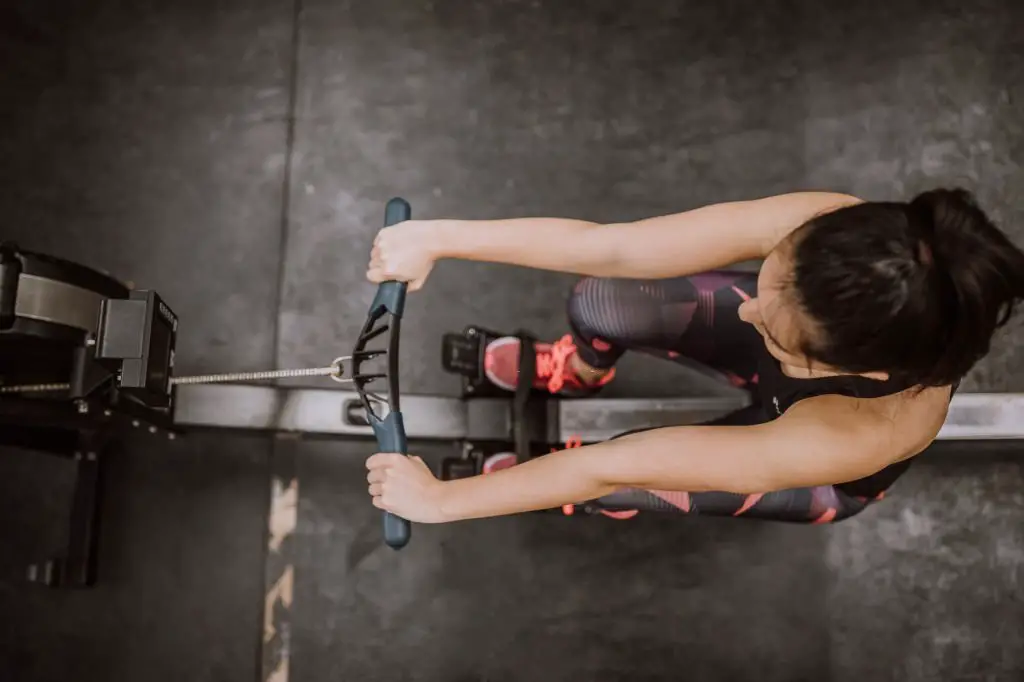Are you new to the rowing machine and wondering if your 500-meter time of two minutes is good? Rowing is a great full-body workout that can challenge even the fittest individuals. In this guide, we’ll dive into understanding rowing metrics, mastering technique, and beginner workouts to help you get started on your journey. Let’s get paddling!
Table of Contents
Understanding Rowing Metrics
When it comes to rowing metrics, hitting 500 meters in 2 minutes is a great accomplishment for beginners. However, keep in mind that this alone doesn’t mean you’re an expert at rowing just yet. To truly understand your progress and improve your technique, it’s important to track other metrics such as stroke rate, split time and distance covered per stroke. This will give you better insights into the efficiency of your movements and help you work towards achieving faster times with less effort.
Understanding these additional rowing metrics can seem intimidating at first but don’t let that hold you back! Take some time before each workout to familiarize yourself with them and set achievable goals based on previous results. With patience and consistency, you’ll soon find yourself making significant improvements on the rowing machine.
What does 500 meters in 2 minutes mean?
Understanding the concept of split time is crucial in rowing. When we say 500 meters in 2 minutes, this means that your split time for each stroke was around 2 minutes divided by 500 meters or about four seconds per stroke. Split time is a valuable metric to track because it allows you to measure your progress and compare yourself with other rowers.
Split time is a valuable metric in rowing, allowing you to measure progress and compare yourself with other rowers. A split time of 500 meters in 2 minutes indicates around four seconds per stroke!
To calculate your personal best for a specific distance, make sure to log all of your workout data consistently as this will help guide you towards improvement. Consistency is key when it comes to tracking metrics like split times, strokes per minute (SPM), and watts produced during a workout session. It can be tempting to push too hard at once but pacing yourself over longer distances will allow you to achieve more consistent results and ultimately improve faster.
Overall, understanding these concepts and tracking them consistently are essential components of improving on the rowing machine. So next time someone asks if rowing 500 meters in two minutes is good – remember that it’s not just about hitting numbers but also making steady progress with each stroke!
What are other rowing metrics to track?
Stroke Rate and Power Output:
Two important metrics to track during your rowing workout are stroke rate and power output. Stroke rate is the number of times you row per minute, while power output measures the amount of energy you’re exerting with each stroke. To improve these metrics, focus on maintaining proper form, engaging your core muscles, and gradually increasing intensity over time.
Distance Covered Over Time:
Tracking the distance you cover over a set period can be a helpful way to set goals for endurance training. For beginners, aim to increase your total distance covered by 10% each week until you reach your desired target. This will help build up your stamina and prepare you for more intense workouts in the future.
Heart Rate and Recovery Time:
Using data from heart rate monitors can also be beneficial when tracking progress on the rowing machine. Keeping an eye on both heart rate during exercise as well as recovery time after exercise can give insight into overall fitness levels and identify areas where improvement is needed. Aim to keep rest periods between sets short but manageable so that breathing remains steady throughout each workout session.
Mastering Rowing Technique
Proper form is key when it comes to mastering rowing technique. Not only does it help you avoid injury, but it also allows you to row more efficiently and effectively. Some key aspects of proper form include keeping your back straight, engaging your core muscles, and using a smooth motion throughout the stroke.
While proper form is important, it’s also essential to be aware of common mistakes and how to avoid them. These can include improper foot placement or grip on the handlebar, lifting too much with your arms instead of using your whole body for power, or even just going too fast without focusing on technique. By practicing correct form and avoiding these mistakes early on in your rowing journey, you’ll set yourself up for success in mastering the sport over time.
Proper Form: The Key to Efficient Rowing
When it comes to rowing, proper form is vital for achieving an efficient workout. To start, sit tall with your shoulders relaxed and engage your core muscles. As you pull the handle towards your body, keep your elbows close to your sides and use a smooth motion rather than jerking or bouncing. Finally, finish the stroke by leaning back slightly while keeping good posture. With practice and attention to detail, mastering this technique will lead to better results in less time.
Avoid common mistakes such as rushing through the movement or hunching over during each stroke – these can cause strain on muscles and limit progress. Remember: take it slow at first until you get comfortable with the rhythm of the exercise. Practicing proper technique from day one will give you a solid foundation for building endurance and strength over time!
Common Mistakes: How to Avoid Them
One common mistake beginners make on the rowing machine is not setting the resistance level properly. Setting it too high or too low can result in inefficient technique and an unsatisfying workout. A good rule of thumb for beginners is to start with a lower resistance and gradually increase as they improve their form and stamina.
Another mistake to avoid is relying solely on arm strength while rowing. Rowing should primarily involve using leg muscles, followed by engaging core muscles, then arms. Using only the arms will tire out quickly and may even cause injuries over time. Remember to use proper form and engage all major muscle groups for an effective workout on the rowing machine.
Workouts for Beginners
When starting out with rowing, it can be overwhelming to know where to begin. A great place to start is with a warm-up routine that focuses on stretching and mobilizing the muscles used in rowing. This will help prevent injury and prepare your body for the workout ahead.
Once you’re warmed up, try beginner workout #1: 500m sprints. Row as hard as you can for 500 meters, then rest for a minute before repeating the sprint two more times. As you progress, aim to decrease your rest time between sprints or increase the number of reps.
For those looking for an endurance challenge, try beginner workout #2: 2000m endurance. Row at a steady pace without stopping until you reach 2000 meters. Focus on maintaining proper technique throughout this longer workout.
After completing either of these workouts, don’t forget to cool down by stretching and taking deep breaths to lower your heart rate gradually.
Warm-up Routine
Before hopping onto the rowing machine, it’s important to properly warm up your muscles. Start with dynamic stretching exercises for your arms, legs and back to get the blood flowing and prepare your body for exercise. Next, spend 3-5 minutes lightly rowing at a moderate pace to increase your heart rate and further warm up those muscles.
Once you’re feeling warmed up, it’s time to practice proper rowing technique with slow, controlled strokes. This will help you familiarize yourself with the movement pattern while avoiding injury from overexertion or poor form. Don’t rush this step – take as much time as you need until you feel comfortable moving on to more intense workouts.
Beginner Workout #1: 500m Sprints
Set the resistance level to a manageable setting and get ready for Beginner Workout #1: 500m Sprints. The goal of this workout is to row as fast as possible for 500 meters, taking breaks in between sets if needed. It’s important to focus on maintaining good posture and form throughout each sprint, so keep your back straight and your shoulders relaxed.
To start, aim for three sets of 500m sprints with a break in between each set. If you need more time to rest or feel like you can handle an additional set, adjust accordingly. Remember that it’s better to go at a slower pace with proper form than speed through the sprints with poor technique.
As a beginner, don’t worry about hitting any specific time goals just yet – focus on building up endurance and getting comfortable on the machine first. With consistent practice and dedication, those fast times will come naturally over time.
Beginner Workout #2: 2000m Endurance
When it comes to building endurance on the rowing machine, Beginner Workout #2: 2000m Endurance is a great place to start. To get the most out of this workout, follow these tips:
- Start at a steady pace that can be maintained over longer distances
- Increase speed gradually every few hundred meters
- Aim to finish the full distance without stopping or slowing down too much
By following these steps and focusing on maintaining your technique, you’ll be well on your way to building up your rowing endurance.
But how do you know if you’re making progress? While there’s no one-size-fits-all answer, as a beginner aiming for 500 meters in 2 minutes is a good goal to work towards. Don’t worry if you’re not there yet – with consistent practice and dedication, progress will come.
Cool-down Routine
After finishing a workout on the rowing machine, it’s important to take some time to cool down and stretch out your muscles. Here are some tips for a good cool-down routine:
- Start with gentle rowing at a slower pace to gradually decrease heart rate and cool down muscles
- Do some static stretches that focus on the upper body to release tension from shoulders, neck & back
- Finish off by foam rolling or using a massage ball on tight areas such as hamstrings or calves.
Taking just 5-10 minutes after your workout can help prevent injury and leave you feeling more relaxed. Remember that consistency is key when it comes to building endurance and strength – so don’t skip out on this important part of your routine!



